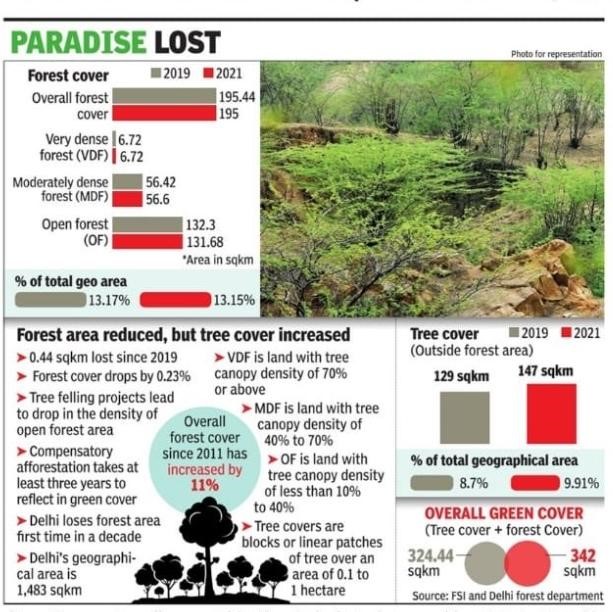30 Years of the Delhi Preservation of Trees Act
Syllabus:
GS 3:
- Conservation , Environmental Pollution and Degradation
- Acts and legislations related to Environmental Conservation.
Why in the News?
The Delhi Preservation of Trees Act (DPTA) completes 30 years amidst increasing concerns about missing trees and illegal felling. The law remains strong on paper but faces challenges in effective implementation.
Green Cover Growth Over 30 Years
- Tree Protection Laws: DPTA was enacted in 1994 to safeguard Delhi’s green cover from shrinking, with strict penalties for violations such as tree felling, pruning, or concrete chokes.
- Expanding Green Cover: Delhi’s green cover expanded from 22 sq km in 1994 to 342 sq km in 2021, largely credited to DPTA and compensatory plantation.
- Compensatory Plantation: For every tree felled, ten saplings must be planted, strengthening efforts toward increasing tree count in the capital.
- Aggressive Plantation Drives: Recent government initiatives include ambitious targets, like planting4 million saplings in 2024, with prior targets successfully met.
- Swift Action Provisions: Before DPTA, action against tree-related offenses was rare, but the law now enables quicker responses under the Forest Department’s oversight.
Lack of Tree Census and Enforcement
- Missing Trees: Despite the law’s intentions, the lack of real-time tree census and monitoring mechanisms hampers efforts to track missing or felled trees.
- Inconsistent Meetings: The Delhi Tree Authority (DTA), tasked with implementing DPTA, has only met 12 times since its inception, weakening enforcement.
- Citizen-Led Census: Local residents, like in Sarvodaya Enclave, have taken initiatives to count trees themselves due to the absence of an official census.
- Court-Mandated Surveys: The High Court-directed surveys revealed double the previously estimated number of missing trees, highlighting gaps in monitoring.
- Enforcement Challenges: Although penalties are in place, enforcement officers remain understaffed, with only one officer per division, straining the effectiveness of DPTA.
Invasive Species Concerns
- Equal Protection for Exotics: DPTA offers the same protection to invasive species like Prosopis juliflora (vilayati kikar), complicating efforts to remove harmful species.
- Need for Categorization: Experts suggest that invasive species should be systematically identified and removed to promote native biodiversity.
- Phased Removal Plans: Authorities advocate for phased removal strategies to manage invasive species without disrupting the ecosystem.
- Impact on Biodiversity: A clearer differentiation between native and exotic species under DPTA could help conserve Delhi’s native biodiversity.
- Policy Revisions: There is growing pressure to revise DPTA to address the challenges posed by exotic species, enhancing its role in biodiversity conservation.
Recent Violations and Legal Battles
- Unpermitted Tree Felling: The illegal felling of over 1,000 trees in Delhi’s southern Ridge in 2024 sparked legal action, highlighting continued issues with unpermitted actions.
- Supreme Court Case: A citizen’s plea brought the case to the Delhi High Court and eventually to the Supreme Court, emphasizing the importance of legal oversight in protecting green spaces.
- Geo-tagging Initiative: The Forest Department’s proposed geo-tagging of trees and 3D mapping aims to track missing trees and monitor green cover more effectively.
- Need for Transparency: Advocates stress the importance of ensuring that tree-related offenses are widely reported and handled transparently under DPTA.
- Citizen Participation: Strengthening public engagement through helplines and awareness campaigns can bolster the Act’s effectiveness in combating tree-related offences.
Way Forward:
- Citizen Empowerment: Environmentalists call for greater public awareness of DPTA’s provisions, urging citizens to report violations using dedicated helplines.
- Inadequate Resources: Despite DPTA’s strong framework, limited manpower and infrastructure within the Forest Department hinder its enforcement.
- Helpline Impact: The government’s helpline allows citizens to report violations, but it requires wider promotion to increase public usage.
- Filing Complaints: Citizens, while empowered by DPTA, often lack knowledge on how to file complaints or whom to approach for tree-related offenses.
- Improved Execution Needed: DPTA’s success hinges on the forest department’s ability to improve execution, address staff shortages, and ensure more active public engagement.
Key Initiatives for enhancing Green Cover
National Afforestation Programme (NAP)
- Promotes afforestation and eco-restoration in degraded forests.
- Implemented through state-level Forest Development Agencies (FDAs).
- Focuses on afforestation, eco-restoration, and capacity building.
Green India Mission (GIM)
- Aims to enhance ecosystem services and forest cover.
- Implemented under the National Action Plan on Climate Change (NAPCC).
- Focuses on afforestation, ecosystem restoration, and community participation.
Compensatory Afforestation Fund (CAMPA)
- Ensures compensatory afforestation for diverted forest land.
- Managed by National and State CAMPA bodies.
- Supports afforestation, forest conservation, and wildlife protection projects.
Conclusion
While the DPTA has significantly contributed to Delhi’s growing green cover over the past 30 years, the lack of a proper tree census, invasive species concerns, and weak enforcement mechanisms highlight critical challenges that need urgent attention for better protection of Delhi’s trees.
Source: Hindustan Times
Mains Practice Question
Evaluate the success of the Delhi Preservation of Trees Act (DPTA) in protecting green cover over the last 30 years. What are the key challenges and areas for improvement?




